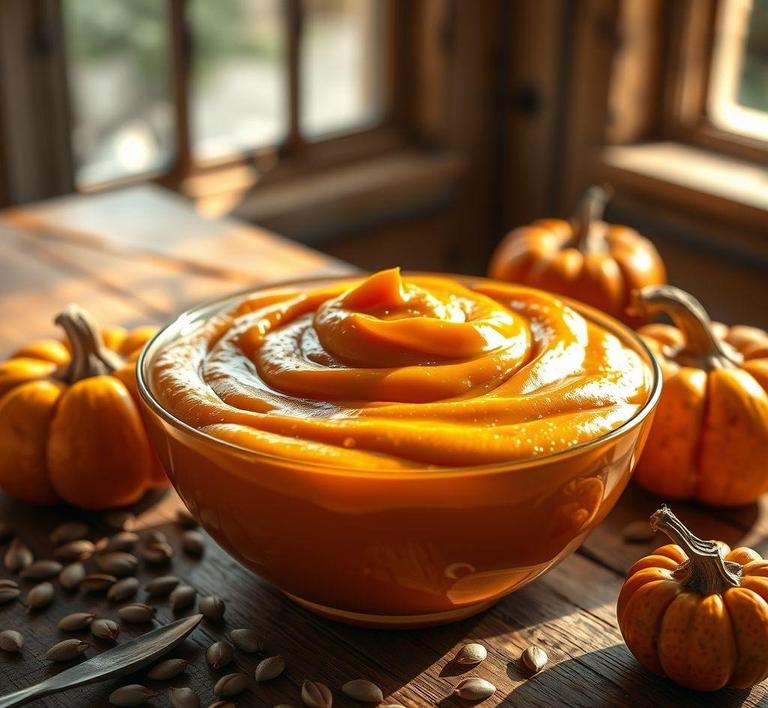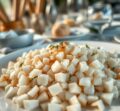If you’ve ever found yourself with extra fresh pumpkin puree after cooking up a fall recipe and wondered if it’s safe to store it for later, you’re not alone! Refreezing fresh pumpkin puree is a great way to extend its shelf life, but there are some important tips to keep in mind. While you can technically refreeze it, the texture and flavor may change after the second freeze. This guide will walk you through the best methods to refreeze pumpkin puree, ensuring it retains as much of its original taste and consistency as possible. Whether you’re prepping for future baking or just trying to make the most of your pumpkin stash, we’ve got you covered!
Can You Refreeze Fresh Pumpkin Puree?

Yes, you can refreeze fresh pumpkin puree-but with some important caveats. From a food safety perspective, refreezing pumpkin puree is acceptable if it was thawed properly in the refrigerator and has not been left at room temperature for more than two hours. If these conditions are met, the risk of bacterial growth remains minimal.
However, the act of refreezing doesn’t come without potential consequences. While the puree may remain safe to eat, its texture, moisture content, and overall quality may deteriorate with each freeze-thaw cycle. Understanding how to do it properly and mitigate the effects of refreezing is key to preserving the puree’s culinary integrity.
How To Refreeze Fresh Pumpkin Puree?
If you’ve found yourself with more thawed pumpkin puree than you need, follow this method to refreeze it safely while minimizing damage to texture and flavor:
-
Assess the Freshness:
Before refreezing, make sure the puree has been stored in the refrigerator and shows no signs of spoilage. It should have a fresh, earthy aroma and a smooth, even texture. Discard it if it smells sour, has a slimy consistency, or appears discolored.
-
Portion It Smartly:
Divide the puree into small, usable portions-typically ½ cup to 1 cup-before refreezing. This way, you avoid repeated thawing and refreezing of the entire batch. Silicone muffin trays or ice cube trays lined with plastic wrap work well for this step.
-
Use Airtight Containers:
Transfer the portions into airtight freezer-safe containers or resealable freezer bags. Remove as much air as possible to prevent freezer burn, which can dry out the puree and give it an off taste.
-
Label and Date:
Clearly label each container with the date of refreezing. While refrozen puree can last up to 2-3 months in the freezer, it’s best used within one month for optimal taste and texture.
-
Thaw Properly:
When you’re ready to use the puree again, always thaw it slowly in the refrigerator. Avoid using a microwave or leaving it at room temperature to thaw, as this encourages uneven temperatures and increases the risk of bacterial growth.
Quality Impact
While refreezing pumpkin puree is safe under the right conditions, it’s important to understand that each freeze-thaw cycle can impact the puree’s quality in subtle but significant ways.
-
Texture Degradation:
Fresh pumpkin puree has a naturally velvety and dense consistency. After refreezing, this texture may become looser or more watery due to ice crystal formation breaking down cell walls. This is especially noticeable when the puree is used in baked goods where texture matters, such as pies or custards.
-
Flavor Diminishment:
Although pumpkin is fairly stable in terms of flavor, each cycle of freezing and thawing can slightly dull its rich, sweet-earthy profile. This is due to minor oxidation and enzymatic changes, which are slow but cumulative over time.
-
Nutritional Changes:
The loss is minimal, but repeated freezing can cause some reduction in water-soluble vitamins like vitamin C and certain B vitamins. This change isn’t usually significant enough to affect the puree’s overall nutritional value in a recipe, but it’s worth noting for those focused on nutrient retention.
-
Performance in Recipes:
Refrozen pumpkin puree may not perform as well in delicate recipes, particularly those that rely on precise textures-like soufflés or creamy desserts. However, it still works beautifully in hearty dishes like soups, stews, breads, or muffins where small changes in consistency are less noticeable.
Refreezing fresh pumpkin puree is entirely feasible and can be a practical solution to avoid waste-so long as it’s handled correctly. Always ensure that the puree has been stored safely, portioned appropriately, and sealed tightly to protect it from freezer burn and flavor loss.
That said, be aware of the inevitable trade-offs: slight texture shifts, minor flavor diminishment, and potential changes in recipe performance. For best results, limit the number of freeze-thaw cycles and use the puree within a month of refreezing.
With a little foresight and proper storage, you can confidently refreeze your pumpkin puree and continue enjoying its autumnal richness long after the harvest season has passed. Whether stirred into a warming soup or folded into moist pumpkin bread, a well-preserved puree ensures none of that golden goodness goes to waste.
Is It Safe To Refreeze Fresh Pumpkin Puree?
Refreezing fresh pumpkin puree is generally safe-but with several important caveats. The safety of refreezing depends on how the puree was stored, handled, and thawed before you attempted to refreeze it. When pumpkin puree is initially frozen, its cellular structure is already somewhat compromised. Thawing and then refreezing a second time accelerates this breakdown, potentially affecting both texture and flavor. However, as long as the puree has been properly thawed in the refrigerator and hasn’t sat at room temperature for more than two hours, it can be safely refrozen.
That said, refreezing can subtly alter the taste and consistency of your pumpkin puree. The moisture content may separate, resulting in a slightly watery texture when thawed again. This isn’t a health concern, but it may impact culinary outcomes, especially in recipes where consistency is crucial-like in silky pumpkin pies or velvety soups.
If you’re refreezing pumpkin puree that has been previously thawed in the microwave or left out on the countertop for extended periods, you should avoid refreezing it altogether. The risk of bacterial growth increases significantly under those conditions, potentially leading to foodborne illness.
Signs That Fresh Pumpkin Puree Should Not Be Refrozen
Knowing when not to refreeze pumpkin puree is just as important as knowing how to do it. Here are some unmistakable signs that your puree should be discarded rather than refrozen:
-
Off Smell:
A sour, fermented, or otherwise unpleasant odor is a clear indicator that the puree has started to spoil. Fresh pumpkin puree has a mild, sweet, earthy aroma. Anything sour or sulfurous means bacterial activity is already in full swing.
-
Discoloration:
While minor darkening can occur with oxidation, any greenish, grayish, or noticeably darker patches suggest spoilage or contamination. Mold may also present as fuzzy spots, and even a small amount means the entire batch should be discarded.
-
Slime or Separation:
Some natural separation (a thin layer of liquid on top) is normal after thawing. However, if the texture has become slimy, stringy, or excessively watery and the solids appear gritty or curdled, it’s best not to refreeze.
-
Extended Time at Room Temperature:
If the puree has been sitting out for more than 2 hours-especially in a warm kitchen-it’s no longer safe to refreeze. Bacteria thrive in the ‘danger zone’ between 40°F and 140°F (4°C to 60°C), and pumpkin puree is no exception.
Common Refreezing Mistakes
Refreezing isn’t complicated, but there are common missteps that can compromise food quality and safety:
-
Refreezing After Microwave Thawing:
Microwaves don’t always thaw food evenly. Some parts of the puree may become warm-inviting bacterial growth-while others remain frozen. Always thaw puree in the refrigerator if you plan to refreeze it.
-
Not Labeling Containers:
It’s easy to lose track of how long something has been in the freezer. Not dating your containers leads to forgotten puree that sits too long, potentially spoiling or developing freezer burn.
-
Repeated Freeze-Thaw Cycles:
Each time you freeze and thaw pumpkin puree, its structure degrades further. Avoid taking out the entire batch if you only need a small portion. Instead, freeze it in measured portions-like in ice cube trays or ½-cup containers.
-
Poor Packaging:
Improper containers lead to freezer burn. Exposed surfaces lose moisture and develop icy crystals. Always store puree in airtight, freezer-safe containers or heavy-duty freezer bags with as much air removed as possible.
Tips And Tricks
Preserving the freshness, flavor, and safety of your pumpkin puree is all about smart storage and handling. Here are some pro tips to keep your puree pristine:
-
Portion Before Freezing:
Use silicone muffin trays or ice cube molds to freeze small, usable quantities. Once frozen, transfer to freezer bags and label with the date and portion size. This way, you thaw only what you need, reducing waste and the need for refreezing.
-
Use a Vacuum Sealer:
Removing air before freezing drastically extends shelf life and prevents freezer burn. Vacuum-sealed bags are ideal if you freeze large quantities of puree regularly.
-
Double Wrap for Protection:
If you’re using freezer bags, consider a second outer layer-like aluminum foil or a second bag-for extra insulation and to protect against freezer temperature fluctuations.
-
Label with Purpose:
Include not just the date, but the intended use: “Pumpkin puree – for muffins”, or “Pumpkin puree – pie grade”. This helps you remember which batches are suited to which recipes, especially if texture has been altered.
-
Add Flavor After Thawing:
Don’t add spices, cream, or sugar before freezing, especially if you plan to use the puree in multiple types of recipes. Freeze plain puree and customize it after thawing.
Conclusion
Refreezing fresh pumpkin puree isn’t inherently dangerous-but it does require careful consideration of handling, storage, and timing. When done correctly, it allows you to make the most of seasonal pumpkins and reduce waste without sacrificing quality or safety. The keys are proper thawing, attentive inspection for signs of spoilage, and strategic portioning before that first freeze.
Whether you’re saving leftover puree from your autumn baking marathon or simply want to extend the life of a homemade batch, thoughtful storage and mindful refreezing practices will ensure that your pumpkin stays as delicious and safe as the day it was pureed. Embrace the freezer as your ally-but wield it wisely.


